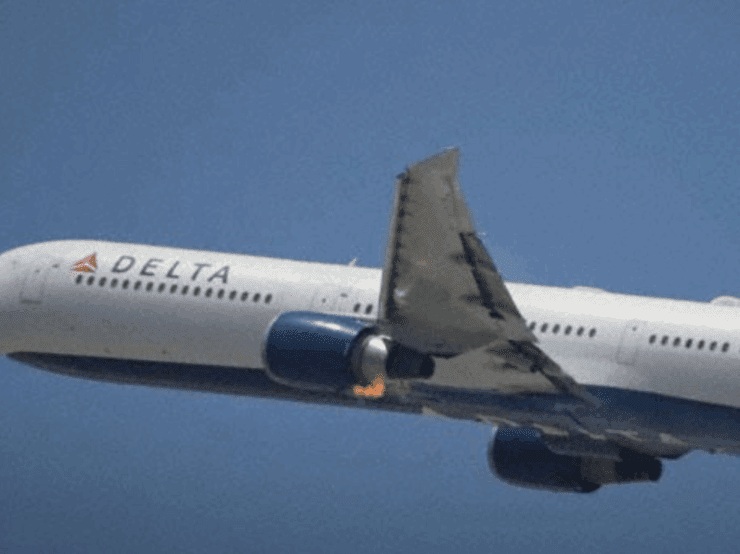News
Delta Engine Fire Drama: 8 Urgent Lessons for Nigerian Airports and Airlines

On July 18, 2025, Delta Air Lines Flight DL446, a Boeing 767-400ER registered N836MH, was forced to make an emergency landing at Los Angeles International Airport (LAX) shortly after takeoff due to an engine fire.
The flight, according to media reports, departing LAX around 2:00 p.m. Pacific Time and headed for Hartsfield-Jackson Atlanta International Airport, experienced a critical situation when its left engine caught fire minutes after departure from runway 25R.
The aircraft, powered by two General Electric CF6-80C2 engines and nearly 25 years old, showed visible flames emanating from the left engine as it climbed out over southern Los Angeles.
Video footage captured by onlookers and the aviation-focused YouTube channel “LA Flights” widely circulated online.
It showed the Boeing 767 with fire from its left engine as it circled over areas such as Downey and Paramount while returning to LAX.
The promptness and composure of the flight crew under pressure played a key role in mitigating what could have escalated into a severe disaster.
As soon as indications of engine trouble and fire were detected via cockpit alerts, the pilots declared an emergency and immediately requested clearance to return to LAX.
Air Traffic Control coordinated closely with the crew, providing a safe flight path back to the airport and alerting emergency services on the ground to prepare for the aircraft’s arrival.
The plane maintained a controlled altitude roughly around 3,000 feet and steady speed during the turning maneuver back towards the runway.
Upon landing on runway 25L, the plane was met by Los Angeles World Airports (LAWA) Aircraft Rescue and Fire Fighting (ARFF) units.
Both units swiftly extinguished the engine fire and ensured the safety of all aboard.
In total, the flight carried 226 passengers, seven flight attendants, and two pilots, none of whom sustained injuries during the incident.
Passengers reported that the flight crew kept them well-informed and calm throughout the emergency, contributing to an orderly evacuation process after touchdown.
Delta Air Lines confirmed that Flight DL446 returned to LAX as a precaution shortly after takeoff following an alert about the possible left engine issue.
A spokesperson emphasized the airline’s commitment to safety and noted that the airline was cooperating fully with an ongoing Federal Aviation Administration (FAA) investigation into the incident.
This event represents the second engine fire involving a Delta Air Lines aircraft within 2025.
In April, an Airbus A330 experienced an engine fire at Orlando International Airport while preparing for departure, successfully evacuating 294 occupants without injuries.
Earlier in January, a Delta A330neo had returned to Atlanta after an engine fire shortly after takeoff en route to São Paulo.
These incidents have prompted Delta to review and reinforce its safety protocols while collaborating with aviation authorities.
The Boeing 767-400ER, specifically the aircraft involved in DL446, had previously encountered a different technical issue in January 2023 when damage to its right wing flap caused it to divert.
This highlighted the importance of meticulous maintenance oversight for aging but reliable aircraft types in airline fleets.
Nonetheless, the skill and composure of the crew during this engine fire event on July 18th ensured the safe outcome.
The coordinated response of the flight deck, air traffic controllers, and ground emergency teams exemplifies the effectiveness of modern aviation safety procedures.
These procedures are designed to handle in-flight emergencies swiftly and securely.
Visual footage of the engine fire and post-landing firefighting garnered significant attention worldwide.
On the other hand, the incident also serves as a reminder of the critical roles played by training, technology, and communication in maintaining airline passenger safety.
Following the emergency landing, the aircraft was towed to the terminal for further inspection, and full maintenance checks were scheduled to assess and repair the engine damage.
As the FAA investigates the root cause of the engine fire, Delta has pledged transparent cooperation and prioritized passenger welfare above all else.
In summary, Delta Flight DL446’s emergency return to Los Angeles after an engine fire was handled with professionalism and precision, resulting in zero casualties despite a potentially perilous situation.
This incident underscores ongoing challenges in aviation safety, especially with older aircraft, while reaffirming the vital importance of pilot training, rapid decision-making, and ground emergency readiness in safeguarding lives.
LESSONS FOR AIRPORT AND AIRLINE OPERATORS
Airport and airline operators in Nigeria can derive several critical lessons from the recent emergency engine fire and landing incident involving Delta Air Lines Flight DL446 at Los Angeles International Airport.
This event underscores the paramount importance of robust safety protocols, effective emergency response coordination, and continuous crew training.
These are all areas that Nigerian aviation stakeholders must prioritize to strengthen the nation’s aviation safety landscape.
1. Emphasis on Crew Preparedness and Training
Delta’s flight crew quickly identified the engine fire, promptly declared an emergency, and executed a safe return to the airport.
This effective response highlights the value of rigorous pilot and crew training in handling in-flight emergencies.
Nigerian airlines and airport operators should continuously invest in realistic simulator training focused on emergency scenarios such as engine fires, mechanical failures, and rapid decision-making under stress.
The recent Memorandum of Understanding between Nigeria’s Safety Investigation Bureau (NSIB) and Aero Contractors.
These should be with the aim to enhance human capital development through industry-led training illustrates the importance of such initiatives.
2. Importance of Advanced Aircraft Maintenance and Monitoring
The incident involved a Boeing 767-400 encountering an engine fire shortly after takeoff, underscoring the criticality of stringent aircraft maintenance and proactive engine health monitoring.
In Nigeria, maintenance standards remain a recurrent concern as reported delays, mechanical failures, and runway incidents attest to aging fleets and regulatory enforcement gaps.
Aviation stakeholders must adopt comprehensive maintenance regimes aligned with manufacturers’ guidelines and regulatory requirements issued by the Nigeria Civil Aviation Authority (NCAA).
Embracing predictive maintenance technologies can also help identify and rectify faults earlier, preventing in-flight failures.
3. Rapid and Coordinated Emergency Response
The swift arrival and action of airport fire crews at LAX were instrumental in safely extinguishing the engine fire upon landing.
Nigerian airports can learn from this by ensuring that their emergency services units are strategically trained, well-equipped, and on standby to respond immediately to incidents.
Considering Nigeria’s history of runway incursions, aircraft skids, and other emergencies, reinforcing Aircraft Rescue and Fire Fighting (ARFF) capabilities at airports is vital.
Additionally, standard operating procedures must be regularly reviewed and drilled between airport emergency services, air traffic controllers, and airline operators to guarantee seamless coordination.
4. Reliable Communications Between Flight Crew and Air Traffic Control
Effective communication between the flight crew and Los Angeles Air Traffic Control ensured a safe return path and rapid activation of ground emergency services.
Nigerian operators should continue to emphasize and enhance communication protocols for emergency situations.
Given challenges in Nigerian airspace management and airport operations, seamless dialogue channels are essential for timely decision-making and coordination during crises.
5. Need for Rigorous Airport Certification and Safety Audits
A notable issue within Nigerian aviation has been operations at uncertified airports with suboptimal infrastructure and safety oversight.
This is a situation that can void insurance coverage and raise risk levels.
Learning from LAX’s well-maintained facilities and comprehensive emergency preparedness, Nigerian airport authorities such as the Federal Airports Authority of Nigeria (FAAN) must prioritize certification compliance.
They must also prioritize infrastructural upgrades and adherence to international safety standards as governed by NCAA regulations.
6. Upholding Safety Management Systems
Delta’s case reflects the efficacy of a well-implemented Safety Management System (SMS), endorsed by the NCAA for Nigerian operators.
SMS frameworks help identify hazards, assess risks, and implement mitigations before incidents occur.
Nigerian airlines and airports need to rigorously apply SMS principles, fostering a culture of safety awareness at all operational levels to pre-empt emergencies rather than merely responding to them.
7. Transparency and Passenger Communication
Despite the emergency, Delta’s crew kept passengers informed and calm throughout the incident.
Nigerian airlines must similarly ensure transparent, timely passenger communication during disruptions and emergencies.
With Nigeria’s past challenges around passenger dissatisfaction and compensation for delays and cancellations, enhancing communication practices can improve passenger safety perceptions and trust.
8. Collaborative Industry and Regulatory Efforts
The Delta incident reinforces the importance of collaboration between airlines, airports, and regulators. Nigeria’s recent NSIB and Aero Contractors partnership aims to build capacity and share expertise, a model that should be extended across the country’s aviation ecosystem to harmonize safety practices and investigative capabilities.
In summary, Nigerian aviation operators can glean vital lessons from Delta Air Lines’ engine fire emergency:
-
Prioritize continuous crew training and emergency preparedness
-
Strengthen rigorous maintenance and early fault detection mechanisms
-
Ensure rapid, well-coordinated airport emergency responses
-
Maintain reliable communication channels between pilots and controllers
-
Accelerate certification and upgrade of airport infrastructure for safety and insurance compliance
-
Implement and uphold comprehensive Safety Management Systems
-
Foster transparent communication with passengers during emergencies
-
Encourage collaborative frameworks between regulators and industry stakeholders
By integrating these lessons, Nigeria can address its existing safety challenges and enhance the reliability and resilience of its aviation sector, ultimately safeguarding passengers and improving operational standards consistent with global best practices.
For Diaspora Digital Media Updates click on Whatsapp, or Telegram. For eyewitness accounts/ reports/ articles, write to: citizenreports@diasporadigitalmedia.com. Follow us on X (Fomerly Twitter) or Facebook











